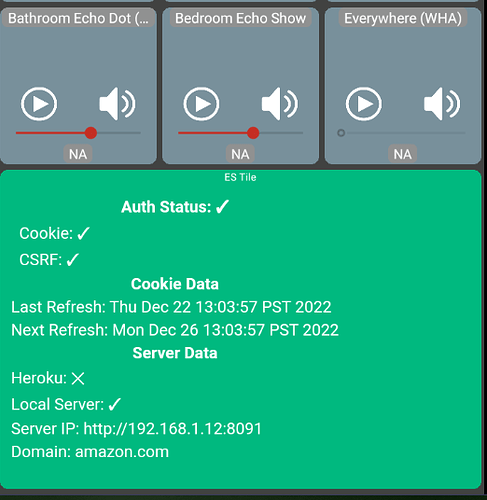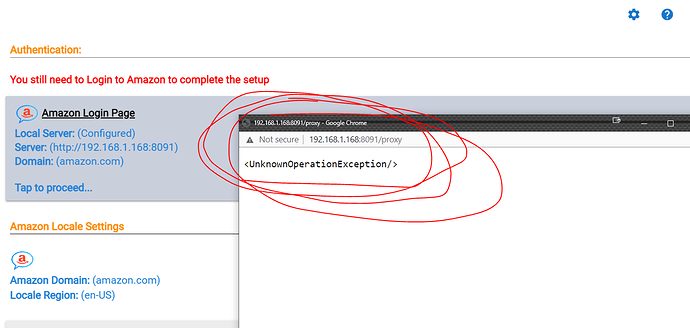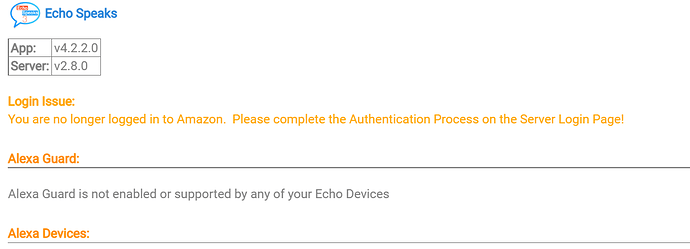I actually never quite understood what did/didn’t work before/after Amazon broke that.
Among other things it provided the last spoken to device.
I’m not sure why you would see that WS driver in the HPM manifest. It’s been removed for over a year
I plan to implement it again using the same socket the Alexa devices use. I just haven’t had the ambition to 
All that’s missing is real-time volume level, media info, and last spoken-to status info
Web socket was for echo speak, I was having multiple issues... HPM started working and found updates.. then I had to run out.. will play with it more later.
I am getting this error when I got to login into Amazon. I logged in once but it says I need to log in again, so I tried to and that's when I got this error. Any ideas on how to fix it? non-docker install if it matters, on a raspberry pi
Where are you running the server? Still on Heroku?
I have a similar problem. I host the ES server on a Synology Docker container. The Synology has a LAN ip of 192.168.1.77 and a VPN connection that is 10.23.112.1. For reasons I have never been able to determine, the Synology Default Gateway, which should be 192.168.1.1, reverts to the VPN gateway of 10.23.112.x. (There is a place in the Synology Control Panel - Network - Network Interface to set the default gateway, but it is not sticky and keeps going back to the VPN ip.) When it does this, the Echo Speaks app picks it up and decides to use it for reaching port 8091 (i.e. 10.23.112.1:8091). It then fails because that ip:8091 does not exist.
The only fix I have found is to restart the ES Docker container and clear the credentials in the ES app. I am far from understanding the inner workings of this system, but I think what I need is a way to manually specify the ip.
How did you get that ES Tile Icon and display cookie data? Is there a virtual device?
The awesome power of @thebearmay .
I don't see it up on HPM, but somewhere above he posted the link - here's straight out of the driver:
metadata { definition ( name: "ES Tile", namespace: "thebearmay", author: "Jean P. May, Jr.", importUrl:"https://raw.githubusercontent.com/thebearmay/hubitat/main/xxxx.groovy"
The data is straight from my synology NAS 220+ running the Docker form of the Echo Speaks replacement for the Heroku hosting of the Cookie manager we've all been relying on for the last 2+ years. My favorite part of that tile is the validity check and the next update check. I have it on my main dashboard. Thank you @thebearmay !
If you aren't aware of his work - you're missing out! He has created a ton of great stuff and tiles seem to be one of his areas of expertise.
Awesome. Appreciate it!
Just realized I haven’t even moved that up to Github… Now up there at: https://raw.githubusercontent.com/thebearmay/hubitat/main/esTile.groovy
Nice...
I guess I haven't been paying much attention to the capabilities of HE lately... I never even considered something like this before.
lol - when you combine the efforts of @csteele with his css tools, and @thebearmay and his tiles (and so much more) - it really is fun to populate custom dashboards!
Thanks, most of what it is doing is just reading the data that you’ve stored in the app and putting it into a “formatted” attribute. Would be cleaner coming from the app, but I didn’t want to interupt your other efforts on the app (which are greatly appreciated).
If this is something that's interesting to others I can add this in next time I make a new release.





